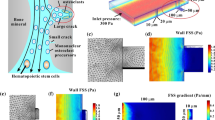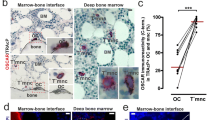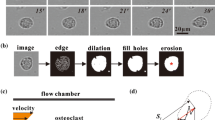Abstract
The adhesion morphology of a cell monolayer results in a mechanical force inside cells, between cells, or between cells and substrates. The mechanical force regulates the differentiation of stem cells, but its influence on cell fusion is seldom studied. The present study is focused on osteoclast precursors, RAW264.7 monocytes, which can fuse into multinucleated cells (MNCs) responsible for bone resorption. Cells were cultured on circular and ring-like patterned substrates. Then, cell fusion, cell–substrate traction force, and force-sensitive molecules in different regions were measured and analyzed. Results showed that MNCs mainly appeared in the interior of the ring-like pattern and the central zone of the circular pattern, where both cell–substrate traction force and in-plane maximal shear stress were smaller than that at the patterns’ edge. The immunostaining results revealed that F-actin, vinculin, β-catenin, and E-cadherin were highly distributed at the edge of patterns. High seeding density of cells promoted mechanical force-dependent fusion. When calcium-dependent cell–cell connections were inhibited by E-cadherin antibody or low-calcium medium, the fusion into MNCs was greatly reduced. Thus, the morphology of cell monolayer decides the mechanical state of cell–substrate interaction and cell–cell connection, ultimately regulating the fusion of osteoclast precursors.








Similar content being viewed by others
References
Anderegg F, Geblinger D, Horvath P, Charnley M, Textor M, Addadi L, Geiger B (2011) Substrate adhesion regulates sealing zone architecture and dynamics in cultured osteoclasts. PLoS ONE 6:e28583
Fu R, Liu Q, Song G, Baik A, Hu M, Sun S, Guo XE, Long M, Huo B (2013) Spreading area and shape regulate apoptosis and differentiation of osteoblasts. Biomed Mater 8:055005
Gautrot JE, Wang C, Liu X, Goldie SJ, Trappmann B, Huck WT, Watt FM (2012) Mimicking normal tissue architecture and perturbation in cancer with engineered micro-epidermis. Biomaterials 33:5221–5229
Guo XE, Takai E, Jiang X, Xu Q, Whitesides GM, Yardley JT, Hung CT, Chow EM, Hantschel T, Costa KD (2006) Intracellular calcium waves in bone cell networks under single cell nanoindentation. Mol Cell Biomech 3:95–107
Hashimoto H, Munro E (2018) Dynamic interplay of cell fate, polarity and force generation in ascidian embryos. Curr Opin Genet Dev 51:67–77
He SJ, Su YW, Ji BH, Gao HJ (2014) Some basic questions on mechanosensing in cell–substrate interaction. J Mech Phys Solids 70:116–135
He S, Liu C, Li X, Ma S, Huo B, Ji B (2015) Dissecting collective cell behavior in polarization and alignment on micropatterned substrates. Biophys J 109:489–500
Helming L, Gordon S (2009) Molecular mediators of macrophage fusion. Trends Cell Biol 19:514–522
Kilian KA, Bugarija B, Lahn BT, Mrksich M (2010) Geometric cues for directing the differentiation of mesenchymal stem cells. Proc Natl Acad Sci USA 107:4872–4877
Kim DH, Wirtz D (2013) Focal adhesion size uniquely predicts cell migration. FASEB J 27:1351–1361
Kim J, Bae WG, Choung HW, Lim KT, Seonwoo H, Jeong HE, Suh KY, Jeon NL, Choung PH, Chung JH (2014) Multiscale patterned transplantable stem cell patches for bone tissue regeneration. Biomaterials 35:9058–9067
Kozlov MM, McMahon HT, Chernomordik LV (2010) Protein-driven membrane stresses in fusion and fission. Trends Biochem Sci 35:699–706
Li P, Hu M, Sun S, Zhang Y, Gao Y, Long M, Huo B, Zhang D (2012) Fluid flow-induced calcium response in early or late differentiated osteoclasts. Ann Biomed Eng 40:1874–1883
Liu CL, He SJ, Li XJ, Huo B, Ji BH (2016) Mechanics of cell mechanosensing on patterned substrate. J Appl Mech Trans ASME 83:8
Ma HW, Hyun J, Zhang ZP, Beebe TP, Chilkoti A (2005) Fabrication of biofunctionalized quasi-three-dimensional microstructures of a nonfouling comb polymer using soft lithography. Adv Func Mater 15:529–540
Mbalaviele G, Chen H, Boyce BF, Mundy GR, Yoneda T (1995) The role of cadherin in the generation of multinucleated osteoclasts from mononuclear precursors in murine marrow. J Clin Invest 95:2757–2765
McBeath R, Pirone DM, Nelson CM, Bhadriraju K, Chen CS (2004) Cell shape, cytoskeletal tension, and RhoA regulate stem cell lineage commitment. Dev Cell 6:483–495
Merle T, Farge E (2018) Trans-scale mechanotransductive cascade of biochemical and biomechanical patterning in embryonic development: the light side of the force. Curr Opin Cell Biol 55:111–118
Moreno JL, Mikhailenko I, Tondravi MM, Keegan AD (2007) IL-4 promotes the formation of multinucleated giant cells from macrophage precursors by a STAT6-dependent, homotypic mechanism: contribution of E-cadherin. J Leukoc Biol 82:1542–1553
Nelson CM, Jean RP, Tan JL, Liu WF, Sniadecki NJ, Spector AA, Chen CS (2005) Emergent patterns of growth controlled by multicellular form and mechanics. Proc Natl Acad Sci USA 102:11594–11599
Plotkin LI, Bellido T (2013) Beyond gap junctions: Connexin43 and bone cell signaling. Bone 52:157–166
Robert J, Pelham J, Wang YL (1997) Cell locomotion and focal adhesions are regulated by substrate flexibility. In: Proceedings of the national academy of sciences of the United States of America, pp 13661–13665
Ruiz SA, Chen CS (2008) Emergence of patterned stem cell differentiation within multicellular structures. Stem Cells 26:2921–2927
Shillcock JC, Lipowsky R (2005) Tension-induced fusion of bilayer membranes and vesicles. Nat Mater 4:225–228
Vuong-Brender TT, Ben Amar M, Pontabry J, Labouesse M (2017) The interplay of stiffness and force anisotropies drives embryo elongation. Elife 6(e23866):1–9
Wan LQ, Kang SM, Eng G, Grayson WL, Lu XL, Huo B, Gimble J, Guo XE, Mow VC, Vunjak-Novakovic G (2010) Geometric control of human stem cell morphology and differentiation. Integr Biol 2:346–353
Acknowledgements
This work was supported by the National Natural Science Foundation of China [11572043 and 11372043 (BH)].
Author information
Authors and Affiliations
Contributions
BH designed the research. QS performed the traction force experiment and numerical simulation, finalized the manuscript. CLL found the phenomenon on first and drafted the first version of manuscript. XB performed the experiments of force-transferring molecules and of cell fusion on circular pattern.
Corresponding author
Ethics declarations
Conflict of interest
We declare that we have no conflicts of interest.
Additional information
Publisher's Note
Springer Nature remains neutral with regard to jurisdictional claims in published maps and institutional affiliations.
Qing Sun, Chengling Liu, Xue Bai are contributed equally to this work.
Electronic supplementary material
Below is the link to the electronic supplementary material.
Rights and permissions
About this article
Cite this article
Sun, Q., Liu, C., Bai, X. et al. Cell–substrate traction force regulates the fusion of osteoclast precursors through cell–cell interaction. Biomech Model Mechanobiol 19, 481–492 (2020). https://doi.org/10.1007/s10237-019-01223-4
Received:
Accepted:
Published:
Issue Date:
DOI: https://doi.org/10.1007/s10237-019-01223-4




